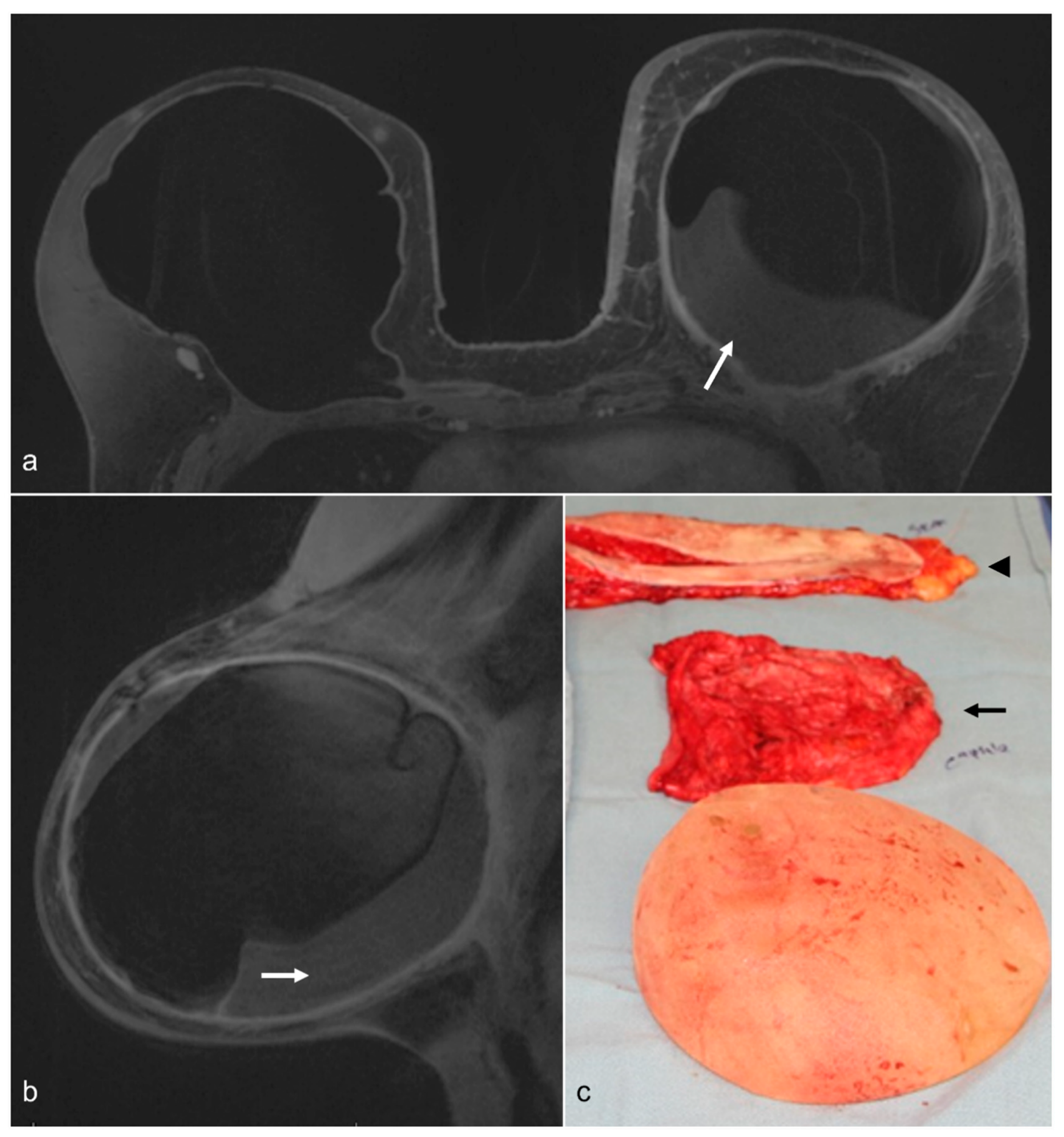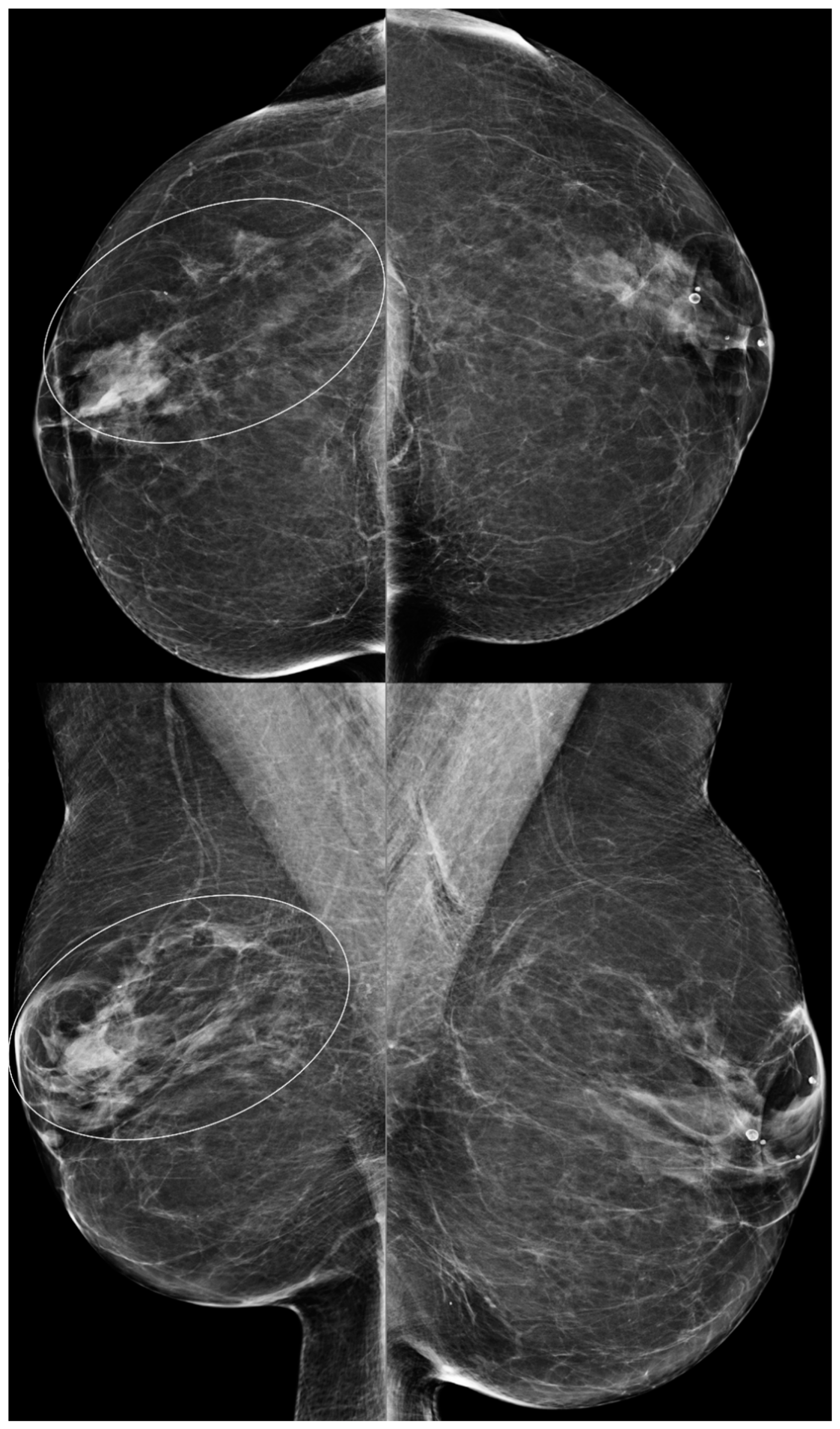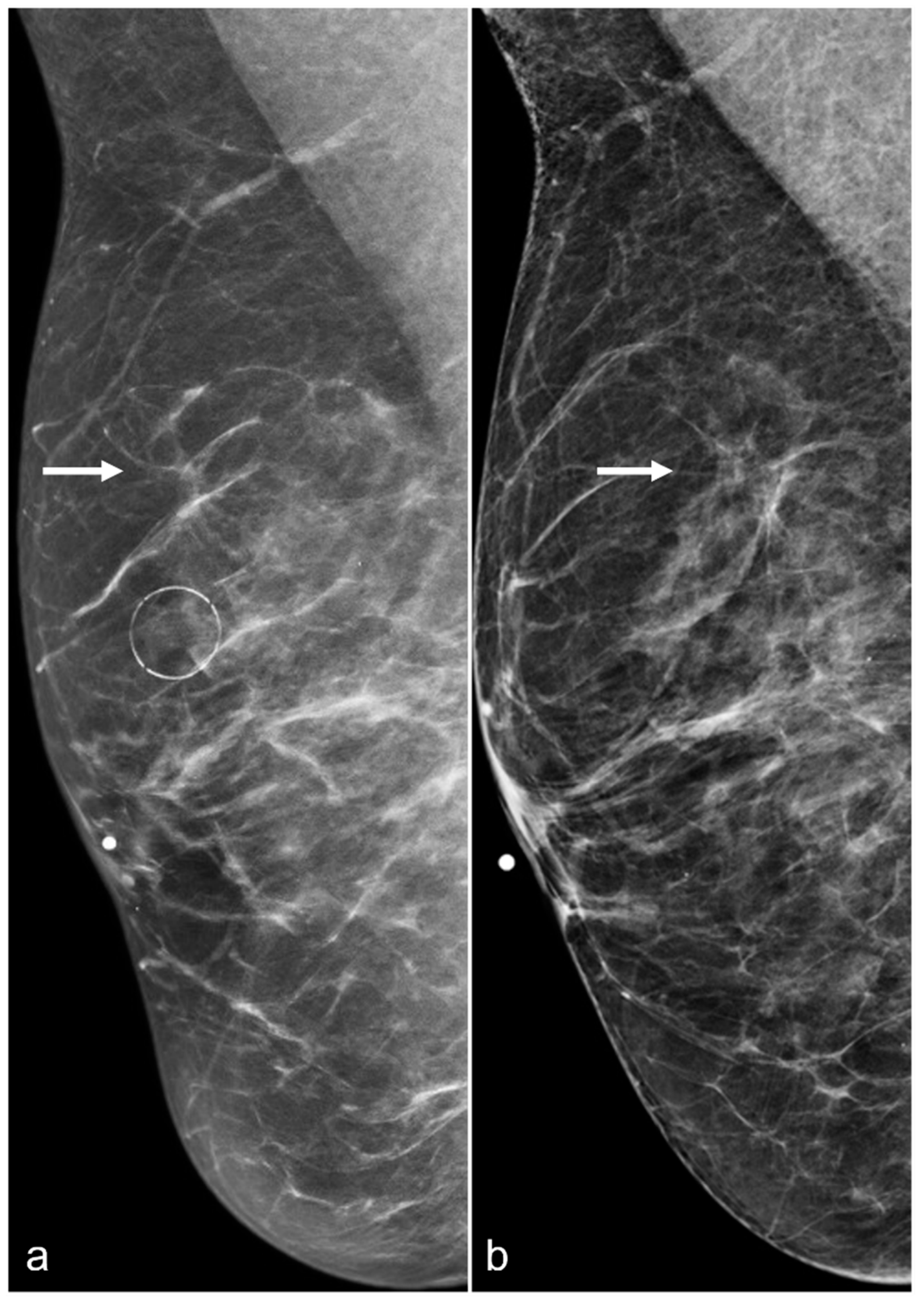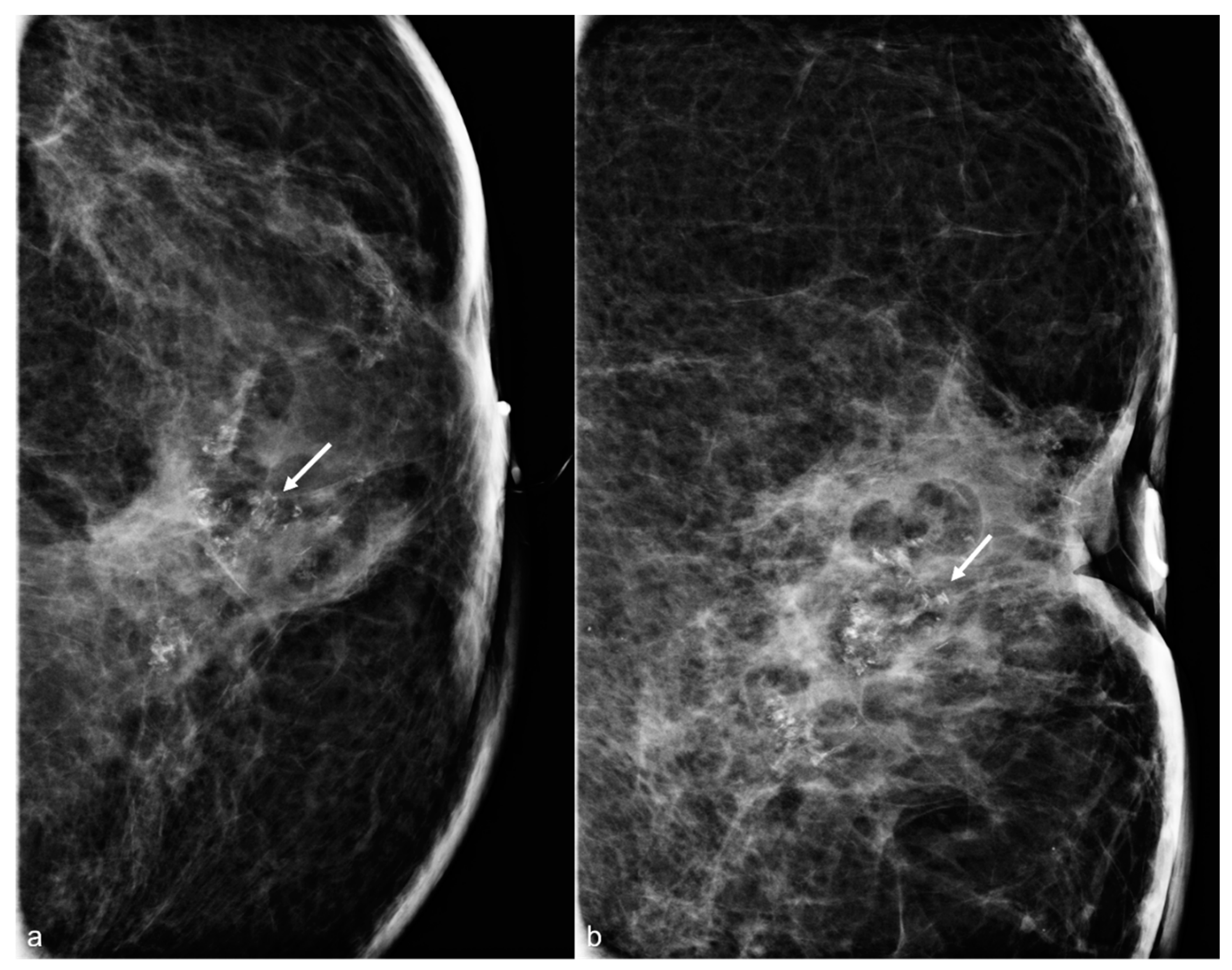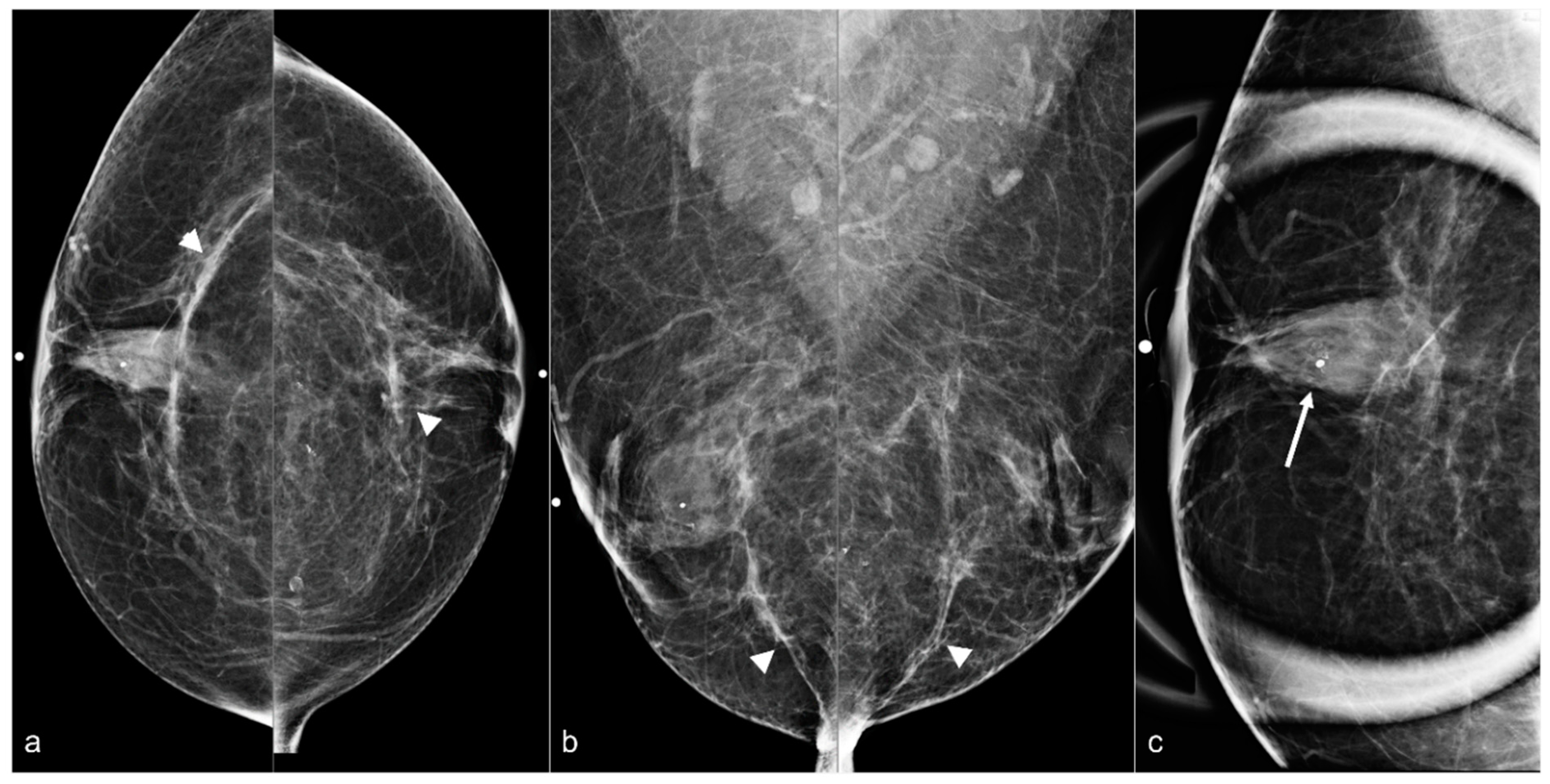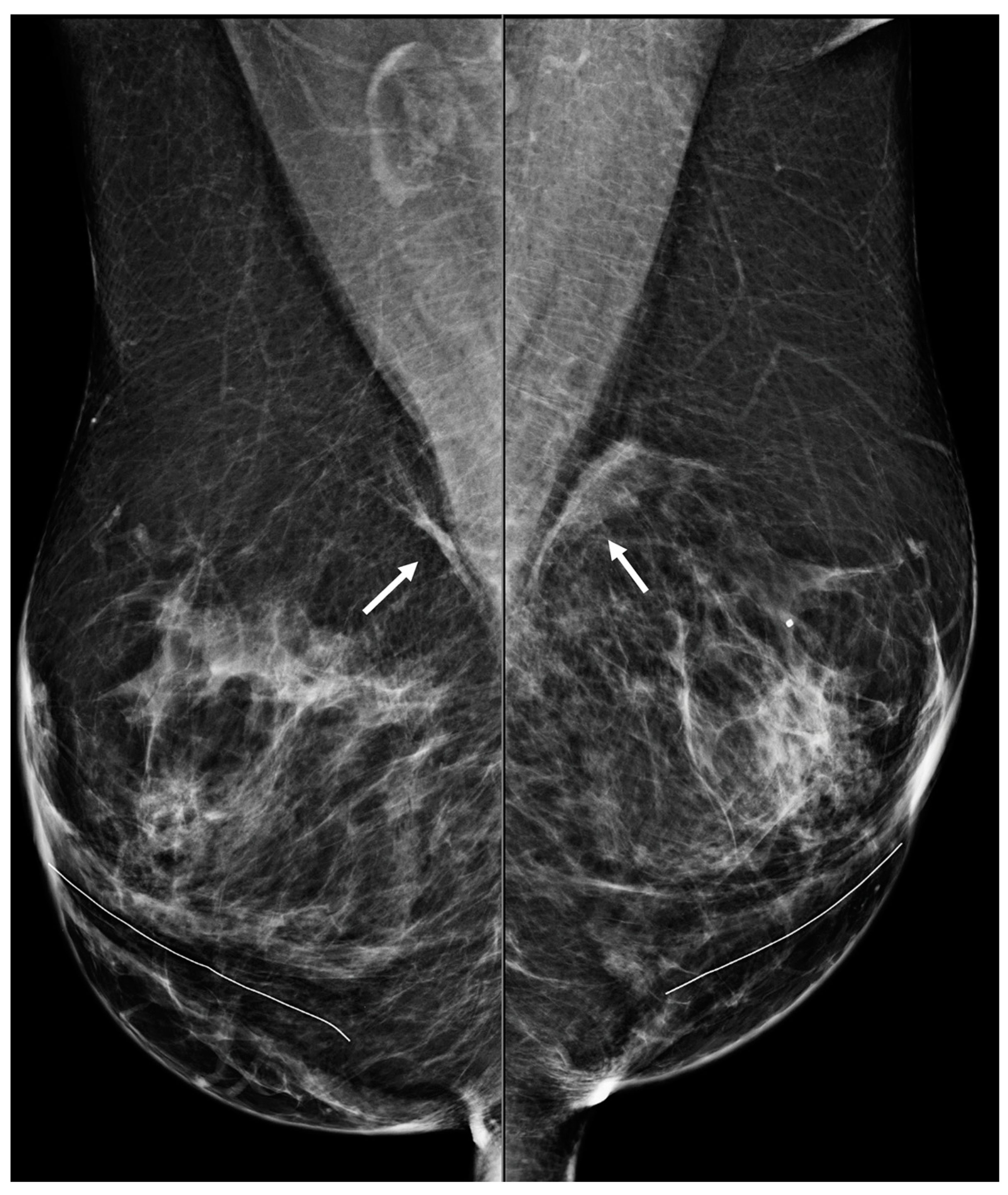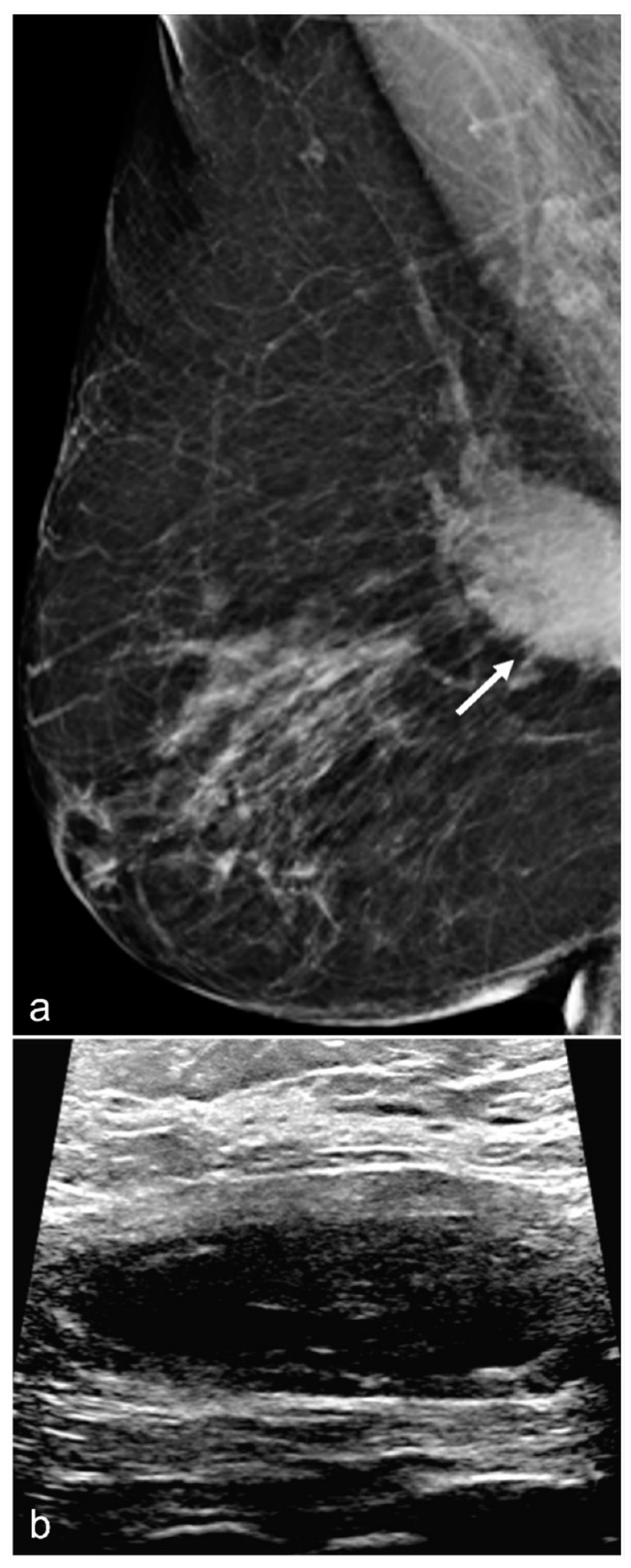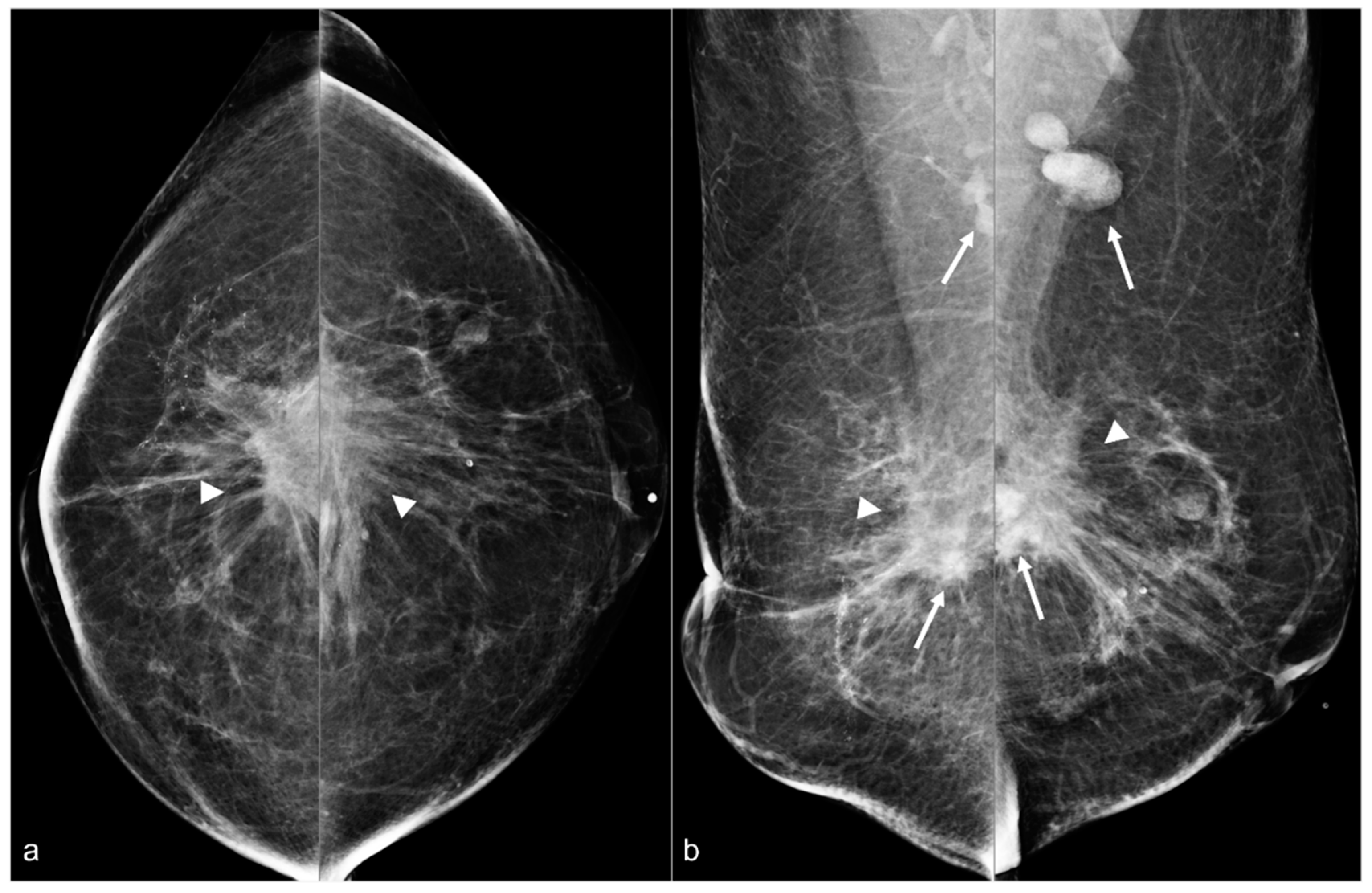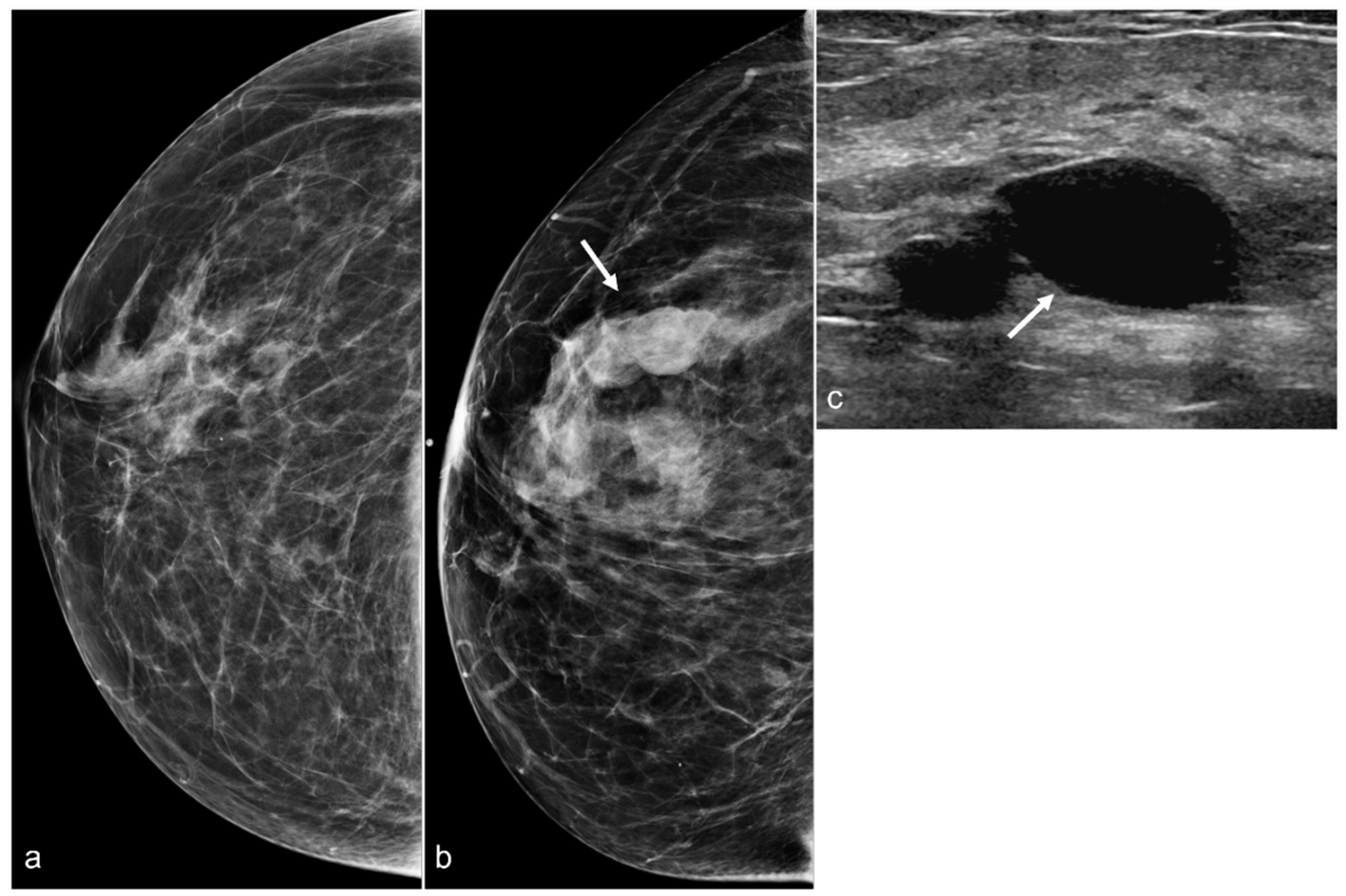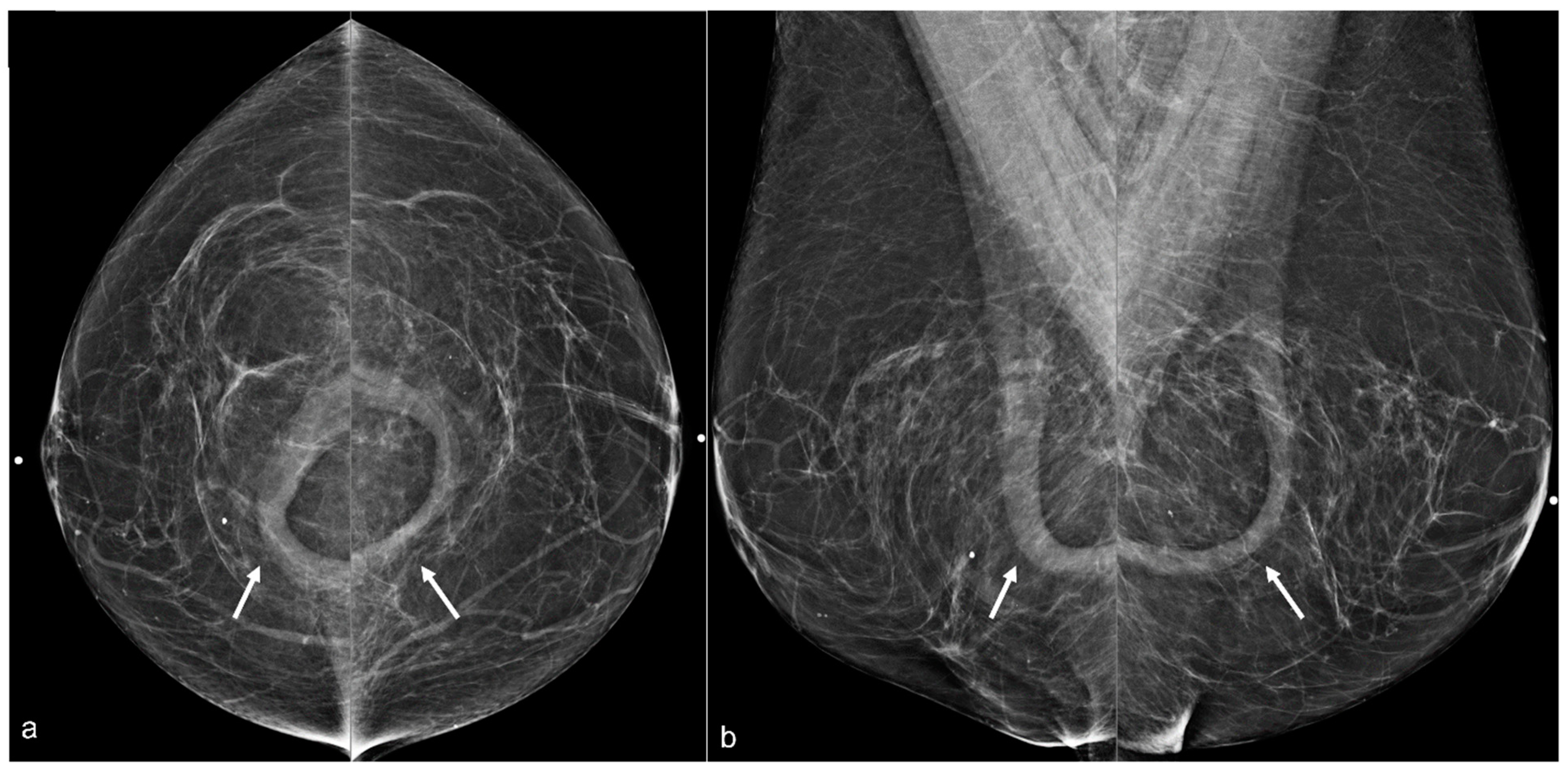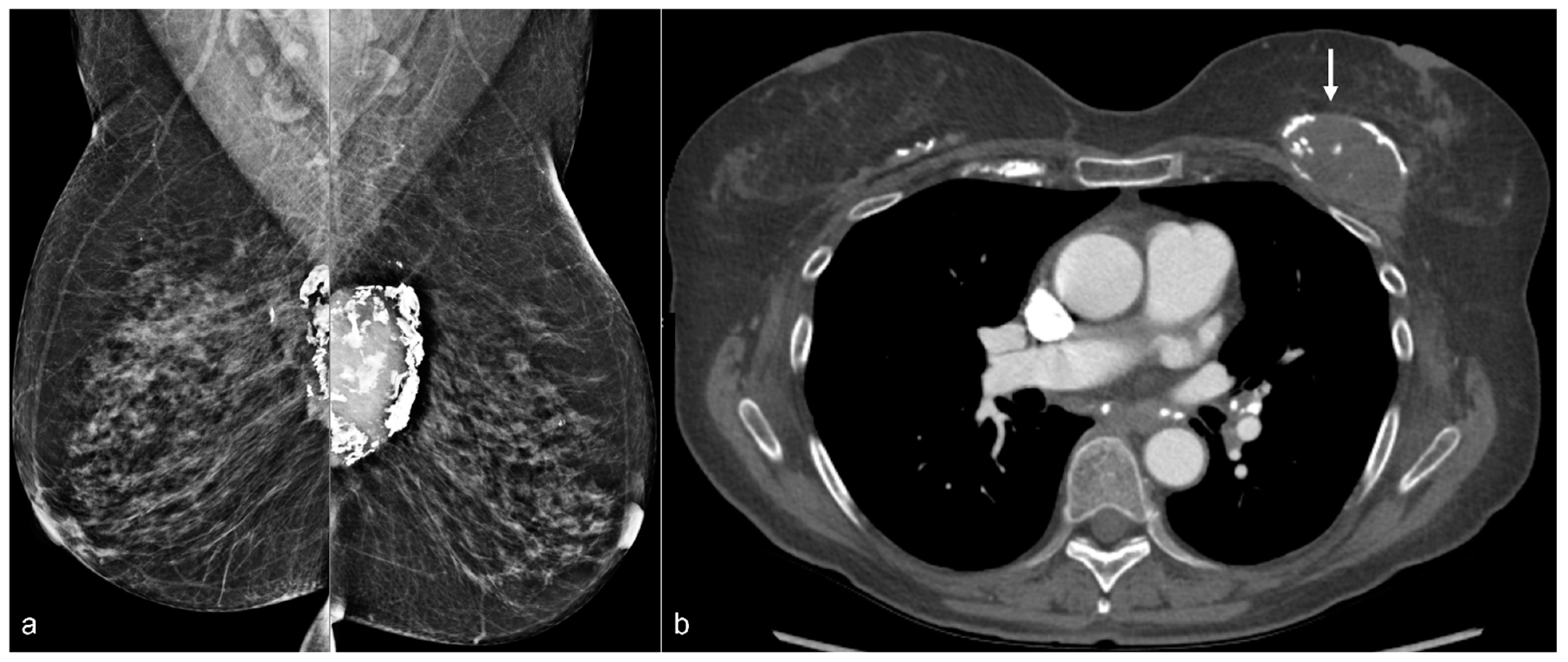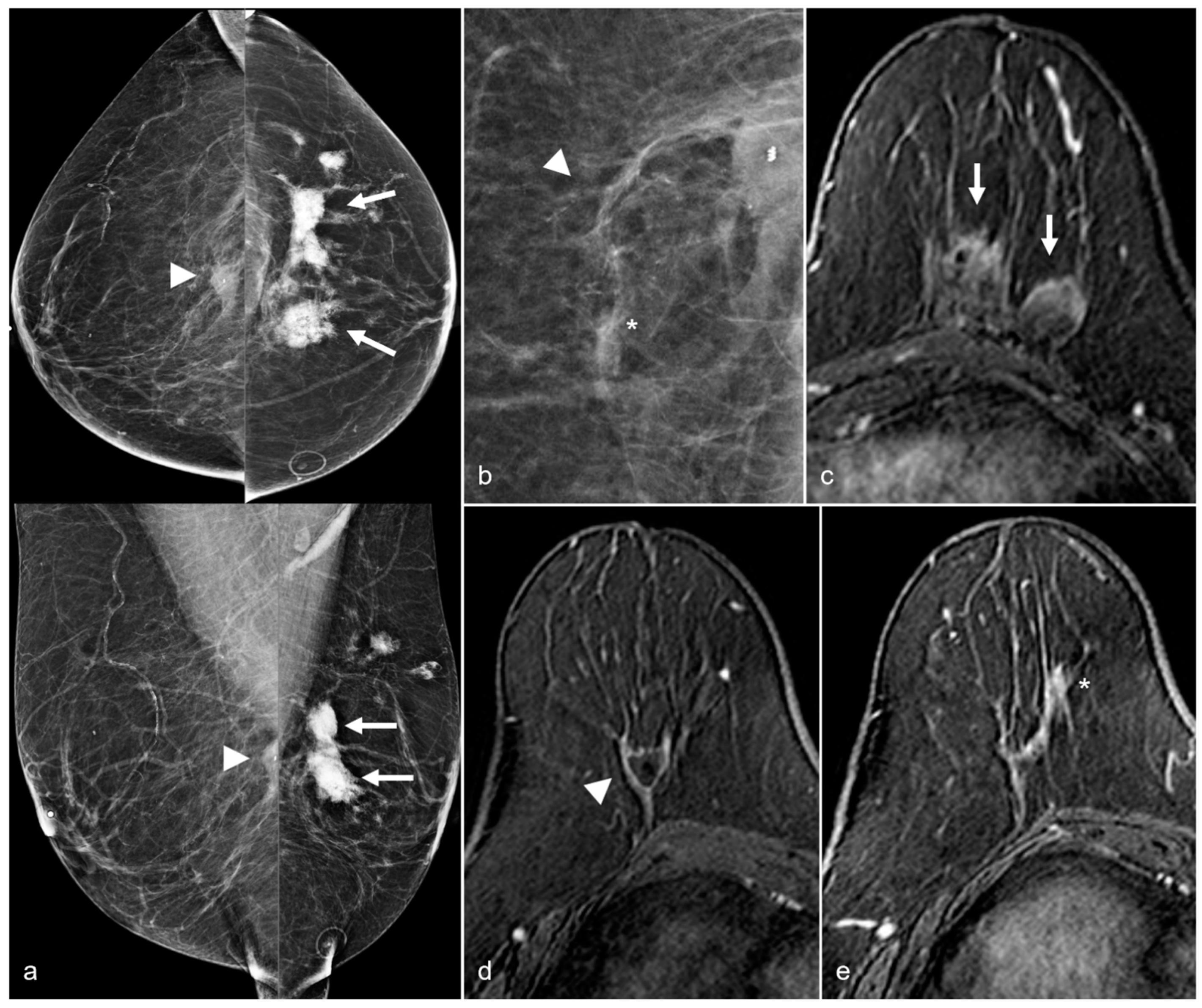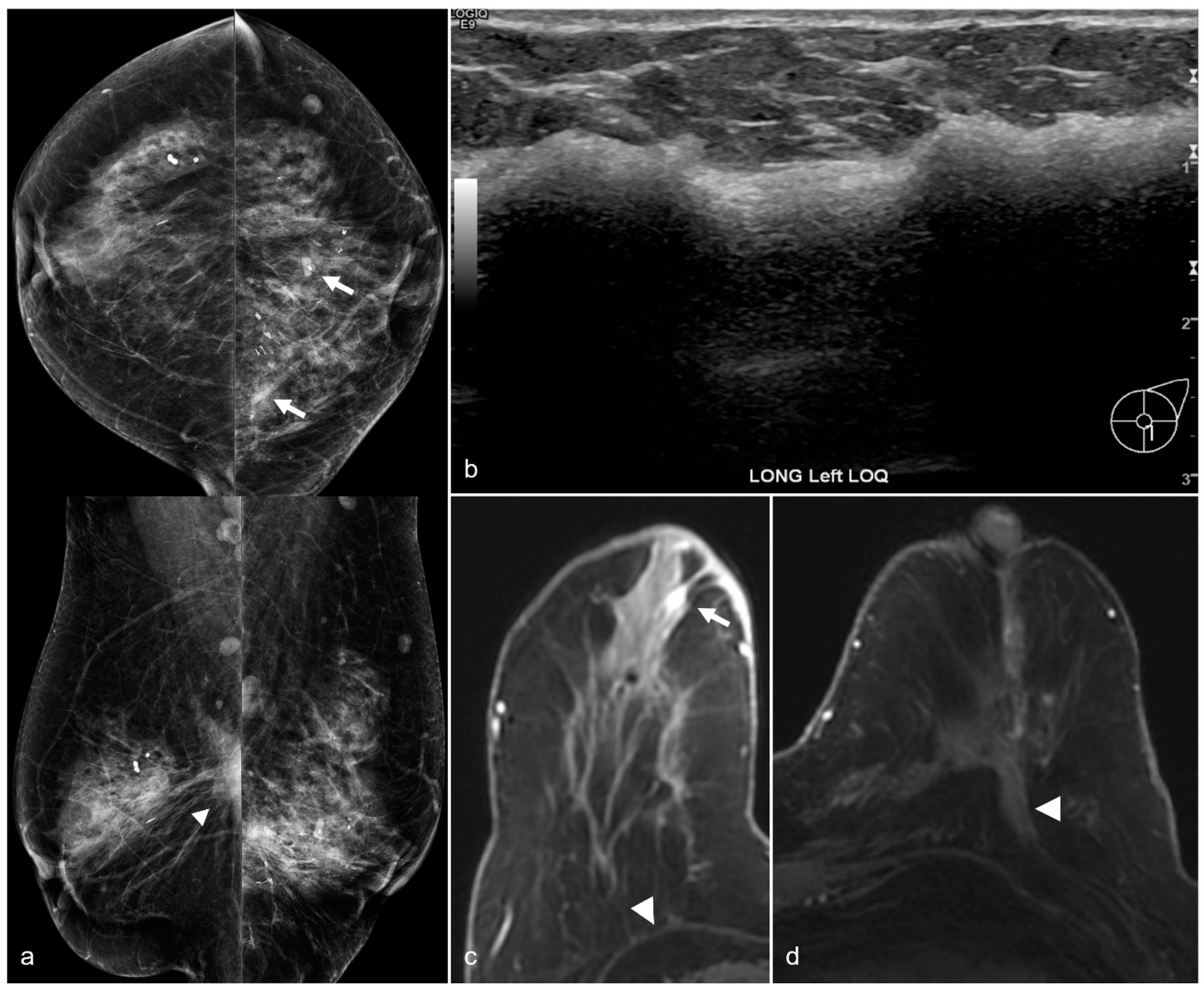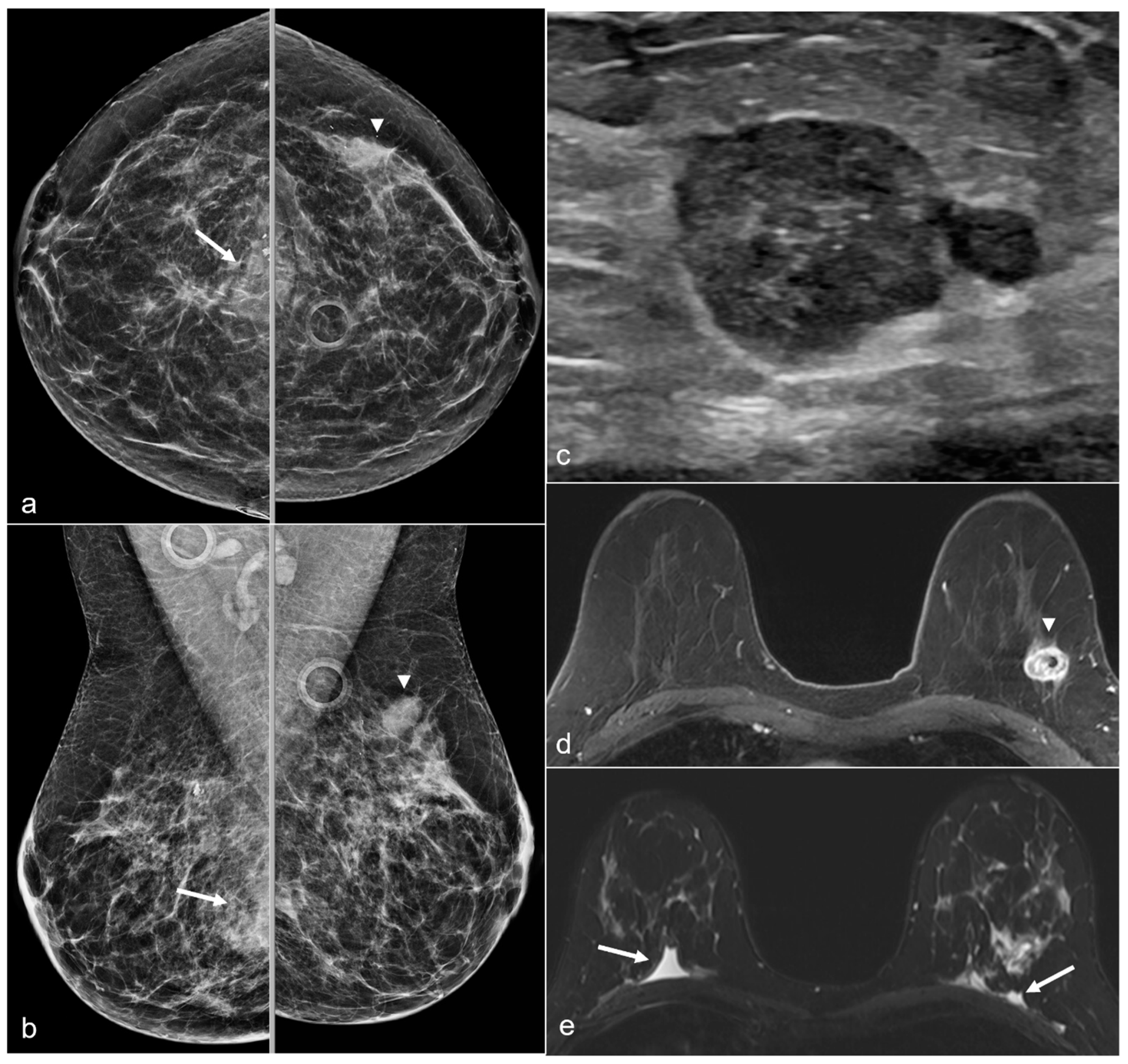Author Contributions
Conceptualization, Y.T.A., M.J.D., M.E.S., M.M.P. and G.J.W.; methodology, Y.T.A. and G.J.W.; investigation, Y.T.A., M.J.D., M.E.S., M.M.P., C.Y., V.J.H. and G.J.W.; resources, Y.T.A., M.J.D., M.E.S., M.M.P., C.Y., V.J.H. and G.J.W.; data curation, Y.T.A., M.J.D., M.E.S., M.M.P., C.Y., V.J.H. and G.J.W.; writing—original draft preparation, Y.T.A. and G.J.W.; writing—review and editing, Y.T.A., M.J.D., M.E.S., M.M.P., C.Y., V.J.H. and G.J.W.; visualization, Y.T.A., M.J.D., M.E.S., M.M.P., C.Y., V.J.H. and G.J.W.; supervision, G.J.W.; project administration, Y.T.A. and G.J.W. All authors have read and agreed to the published version of the manuscript.
Figure 1.
A 58-year-old woman with a history of bilateral prophylactic mastectomy and implant reconstruction. The patient had capsular contracture and a chronic fluid collection in the left breast (white arrows) on T1-weighted contrast-enhanced axial (a) and left sagittal (b) images. She underwent BES, and a photograph of the surgical specimen (c) shows the removed implant, the fibrous capsule (black arrow), and skin (arrowhead).
Figure 1.
A 58-year-old woman with a history of bilateral prophylactic mastectomy and implant reconstruction. The patient had capsular contracture and a chronic fluid collection in the left breast (white arrows) on T1-weighted contrast-enhanced axial (a) and left sagittal (b) images. She underwent BES, and a photograph of the surgical specimen (c) shows the removed implant, the fibrous capsule (black arrow), and skin (arrowhead).
Figure 2.
A 79-year-old woman with BES changes. Bilateral CC (above) and MLO (below) views demonstrate more dense tissue from post-BES changes on the right (ovals) compared to left breast. Note that right breast is smaller than the left breast.
Figure 2.
A 79-year-old woman with BES changes. Bilateral CC (above) and MLO (below) views demonstrate more dense tissue from post-BES changes on the right (ovals) compared to left breast. Note that right breast is smaller than the left breast.
Figure 3.
A 61-year-old woman had a history of subglandular silicone implants, status post BES. Surgical changes including architectural distortion (arrows) were noted in the right breast, stable for two years. ((a) Synthetic 2D MLO view from 2019; (b) 2D MLO view from 2021). The findings were consistent with post-BES change.
Figure 3.
A 61-year-old woman had a history of subglandular silicone implants, status post BES. Surgical changes including architectural distortion (arrows) were noted in the right breast, stable for two years. ((a) Synthetic 2D MLO view from 2019; (b) 2D MLO view from 2021). The findings were consistent with post-BES change.
Figure 4.
A 65-year-old woman with a history of subglandular silicone implants. Mammograms with magnified CC (a) and ML (b) views demonstrate calcified (arrows) and non-calcified fat necrosis in the left central breast. The patient underwent BES four years earlier.
Figure 4.
A 65-year-old woman with a history of subglandular silicone implants. Mammograms with magnified CC (a) and ML (b) views demonstrate calcified (arrows) and non-calcified fat necrosis in the left central breast. The patient underwent BES four years earlier.
Figure 5.
A 54-year-old woman with a history of subglandular silicone implants. Right breast CC view (a) performed 2 years after BES and mammogram performed 3 years after BES CC (b) and magnified CC (c) views demonstrate developing oil cysts (arrows) in the right breast.
Figure 5.
A 54-year-old woman with a history of subglandular silicone implants. Right breast CC view (a) performed 2 years after BES and mammogram performed 3 years after BES CC (b) and magnified CC (c) views demonstrate developing oil cysts (arrows) in the right breast.
Figure 6.
A 58-year-old woman with a history of subglandular silicone implants. BES was performed 1 year before the current mammogram. Bilateral CC (a) and MLO views (b) demonstrate bilateral linear densities indicating fibrous capsules (arrowheads) and bilateral, right greater than left, retroareolar focal asymmetries related to BES. Grouped amorphous calcifications (arrow) seen on a magnified CC view (c) in the right breast retroareolar region were biopsied with stereotactic guidance, with pathology demonstrating fat necrosis and giant cell reaction.
Figure 6.
A 58-year-old woman with a history of subglandular silicone implants. BES was performed 1 year before the current mammogram. Bilateral CC (a) and MLO views (b) demonstrate bilateral linear densities indicating fibrous capsules (arrowheads) and bilateral, right greater than left, retroareolar focal asymmetries related to BES. Grouped amorphous calcifications (arrow) seen on a magnified CC view (c) in the right breast retroareolar region were biopsied with stereotactic guidance, with pathology demonstrating fat necrosis and giant cell reaction.
Figure 7.
A 50-year-old woman with a history of subglandular silicone implants. Mammography with bilateral MLO views one year after BES demonstrates bilateral linear asymmetries (arrows) in the subglandular region.
Figure 7.
A 50-year-old woman with a history of subglandular silicone implants. Mammography with bilateral MLO views one year after BES demonstrates bilateral linear asymmetries (arrows) in the subglandular region.
Figure 8.
A 67-year-old woman with subglandular silicone implants developed a large, dense right subglandular mass (arrow) on mammography (a) two years after BES. Follow-up longitudinal right breast ultrasound (b) demonstrates a fluid collection with internal debris, confirming evidence of a seroma.
Figure 8.
A 67-year-old woman with subglandular silicone implants developed a large, dense right subglandular mass (arrow) on mammography (a) two years after BES. Follow-up longitudinal right breast ultrasound (b) demonstrates a fluid collection with internal debris, confirming evidence of a seroma.
Figure 9.
A 64-year-old woman status post BES due to silicone implant rupture. Spiculated masses (arrowheads) are seen in the pre-pectoral region on bilateral CC (a) and MLO (b) views. Hyperdense material (arrows) in both surgical beds and the bilateral axillae are sequelae of prior silicone implant rupture.
Figure 9.
A 64-year-old woman status post BES due to silicone implant rupture. Spiculated masses (arrowheads) are seen in the pre-pectoral region on bilateral CC (a) and MLO (b) views. Hyperdense material (arrows) in both surgical beds and the bilateral axillae are sequelae of prior silicone implant rupture.
Figure 10.
A 58-year-old woman with a history of BIA-ALCL and subsequent BES of retropectoral silicone implants. Post-BES CC mammogram (a) and most recent mammogram CC view (b) demonstrate developing masses (arrow). Right breast ultrasound in the transverse view (c) shows cysts (arrow).
Figure 10.
A 58-year-old woman with a history of BIA-ALCL and subsequent BES of retropectoral silicone implants. Post-BES CC mammogram (a) and most recent mammogram CC view (b) demonstrate developing masses (arrow). Right breast ultrasound in the transverse view (c) shows cysts (arrow).
Figure 11.
A 67-year-old woman with a history of subglandular silicone implants. Mammograms with bilateral CC (a) and MLO (b) views demonstrate curvilinear densities (arrows), consistent with residual implant capsules.
Figure 11.
A 67-year-old woman with a history of subglandular silicone implants. Mammograms with bilateral CC (a) and MLO (b) views demonstrate curvilinear densities (arrows), consistent with residual implant capsules.
Figure 12.
A 70-year-old patient’s mammogram (a) demonstrates bilateral calcified implant capsules with a dense mass in the left prepectoral location on the MLO view. CT (b) confirms a left breast seroma (arrow) with fibrous capsular calcifications.
Figure 12.
A 70-year-old patient’s mammogram (a) demonstrates bilateral calcified implant capsules with a dense mass in the left prepectoral location on the MLO view. CT (b) confirms a left breast seroma (arrow) with fibrous capsular calcifications.
Figure 13.
Mammograms of a 67-year-old woman with a history of retropectoral silicone implants and BES demonstrating several irregular dense breast masses (arrows) in the right breast on the CC (a) and the MLO (b) views. An ultrasound in the transverse view (c) confirms the classic snowstorm appearance of free silicone (arrowhead).
Figure 13.
Mammograms of a 67-year-old woman with a history of retropectoral silicone implants and BES demonstrating several irregular dense breast masses (arrows) in the right breast on the CC (a) and the MLO (b) views. An ultrasound in the transverse view (c) confirms the classic snowstorm appearance of free silicone (arrowhead).
Figure 14.
A 65-year-old woman with a history of a ruptured subglandular silicone implant. Screening mammogram (a) demonstrates very dense masses (arrows) in the left prepectoral region on the CC and the MLO views. Suspicious right breast calcifications (arrowhead) were biopsied with a biopsy clip seen in a hematoma in the right prepectoral region on the CC and MLO views. Pathology revealed ductal carcinoma in-situ. An additional biopsy was performed in the right breast for a small focal asymmetry (*) better seen on magnified CC view (b) and pathology demonstrated invasive ductal carcinoma. MRI demonstrates a T1 isointense peripherally enhancing silicone granuloma in the left breast prepectoral region ((c), arrows). In the right breast, a biopsy clip is seen within the biopsy cavity ((d), arrowhead). Anterior and inferior to this region (e), there is a linear non-mass enhancement. More anterior and medial to the non-mass enhancement, there is an enhancing mass (*), corresponding to the biopsy-proven invasive ductal carcinoma.
Figure 14.
A 65-year-old woman with a history of a ruptured subglandular silicone implant. Screening mammogram (a) demonstrates very dense masses (arrows) in the left prepectoral region on the CC and the MLO views. Suspicious right breast calcifications (arrowhead) were biopsied with a biopsy clip seen in a hematoma in the right prepectoral region on the CC and MLO views. Pathology revealed ductal carcinoma in-situ. An additional biopsy was performed in the right breast for a small focal asymmetry (*) better seen on magnified CC view (b) and pathology demonstrated invasive ductal carcinoma. MRI demonstrates a T1 isointense peripherally enhancing silicone granuloma in the left breast prepectoral region ((c), arrows). In the right breast, a biopsy clip is seen within the biopsy cavity ((d), arrowhead). Anterior and inferior to this region (e), there is a linear non-mass enhancement. More anterior and medial to the non-mass enhancement, there is an enhancing mass (*), corresponding to the biopsy-proven invasive ductal carcinoma.
![Diagnostics 13 02173 g014 Diagnostics 13 02173 g014]()
Figure 15.
A 79-year-old woman with a history of subglandular silicone implants with a remote history of BES. Mammography (a) demonstrates dense masses in the left breast (arrows) and a right prepectoral asymmetry (arrowhead). Four biopsy clips are also seen in the left breast secondary to prior benign biopsies. Longitudinal left breast ultrasound (b) demonstrates an extensive snowstorm appearance, which limits evaluation of the breasts. T1-weighted post-contrast axial MRI (c) reveals an enhancing 0.3 cm focus in the right central breast (arrow). Subsequent MRI-guided biopsy revealed multifocal LCIS and ALH, and the patient underwent breast conservation therapy. Note the post-BES changes in the bilateral prepectoral regions (arrowheads), which is more pronounced in the left breast (d).
Figure 15.
A 79-year-old woman with a history of subglandular silicone implants with a remote history of BES. Mammography (a) demonstrates dense masses in the left breast (arrows) and a right prepectoral asymmetry (arrowhead). Four biopsy clips are also seen in the left breast secondary to prior benign biopsies. Longitudinal left breast ultrasound (b) demonstrates an extensive snowstorm appearance, which limits evaluation of the breasts. T1-weighted post-contrast axial MRI (c) reveals an enhancing 0.3 cm focus in the right central breast (arrow). Subsequent MRI-guided biopsy revealed multifocal LCIS and ALH, and the patient underwent breast conservation therapy. Note the post-BES changes in the bilateral prepectoral regions (arrowheads), which is more pronounced in the left breast (d).
Figure 16.
A 52-year-old woman with a history of subglandular silicone implants. Prior mammograms with implant displaced views were negative. A screening mammogram with bilateral CC and MLO views one year after BES (a) demonstrates a spiculated mass in the left lower inner quadrant (arrow), which was biopsied under ultrasound guidance with pathology revealing invasive ductal carcinoma. T1-weighted post-contrast MRI axial images demonstrate areas of fat necrosis in both breasts ((b,c), arrowheads). An enhancing mass with a biopsy clip is seen adjacent to the surgical scar ((c), arrow) in the left breast representing the biopsy proven carcinoma.
Figure 16.
A 52-year-old woman with a history of subglandular silicone implants. Prior mammograms with implant displaced views were negative. A screening mammogram with bilateral CC and MLO views one year after BES (a) demonstrates a spiculated mass in the left lower inner quadrant (arrow), which was biopsied under ultrasound guidance with pathology revealing invasive ductal carcinoma. T1-weighted post-contrast MRI axial images demonstrate areas of fat necrosis in both breasts ((b,c), arrowheads). An enhancing mass with a biopsy clip is seen adjacent to the surgical scar ((c), arrow) in the left breast representing the biopsy proven carcinoma.
Figure 17.
A 50-year-old woman with a history of subglandular silicone implants, status post BES. Screening mammograms with bilateral CC (a) and MLO views (b) demonstrate a mass in the left breast upper outer quadrant (arrowhead). BES changes are more prominent in the right breast with focal asymmetries in the prepectoral region (arrows) with dystrophic calcifications. Subsequent ultrasound examination of the left breast in the transverse plane (c) with ultrasound-guided biopsy revealed triple-negative invasive ductal carcinoma. T1-weighted post-contrast MRI (d) revealed a left breast enhancing mass (arrowhead) with a biopsy clip. There was also right greater than left prepectoral fluid (arrows) on the axial T2-weighted images (e).
Figure 17.
A 50-year-old woman with a history of subglandular silicone implants, status post BES. Screening mammograms with bilateral CC (a) and MLO views (b) demonstrate a mass in the left breast upper outer quadrant (arrowhead). BES changes are more prominent in the right breast with focal asymmetries in the prepectoral region (arrows) with dystrophic calcifications. Subsequent ultrasound examination of the left breast in the transverse plane (c) with ultrasound-guided biopsy revealed triple-negative invasive ductal carcinoma. T1-weighted post-contrast MRI (d) revealed a left breast enhancing mass (arrowhead) with a biopsy clip. There was also right greater than left prepectoral fluid (arrows) on the axial T2-weighted images (e).
